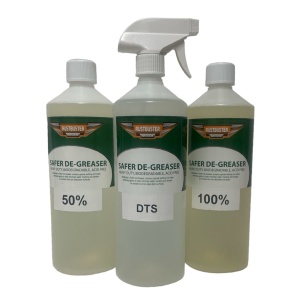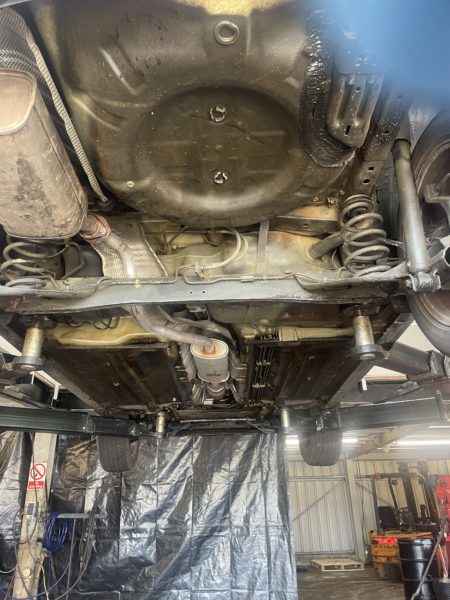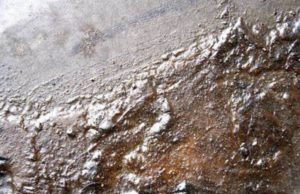Surface preparation chemicals: Why it is essential to de-grease metal before painting.
 Surface preparation, including degreasing, is crucial before painting metal surfaces because it directly impacts the quality and longevity of the paint job. Here are some reasons why de-greasing is essential:
Surface preparation, including degreasing, is crucial before painting metal surfaces because it directly impacts the quality and longevity of the paint job. Here are some reasons why de-greasing is essential:
- Adhesion: One of the primary reasons for degreasing is to improve the adhesion of the paint to the metal surface. Oils, greases, and other contaminants on the metal can create a barrier between the paint and the substrate. If the surface is not properly cleaned, the paint may not adhere well, leading to peeling, chipping, or flaking over time.
- Smooth and Even Coating: A clean, degreased surface allows the paint to spread evenly and smoothly. When the surface is contaminated with oils or greases, the paint may not adhere uniformly, resulting in uneven coverage and an unprofessional finish.
- Prevents Corrosion: Grease and oils can act as a barrier that traps moisture against the metal surface, promoting corrosion and rust formation. By de-greasing the metal, you remove these contaminants, reducing the likelihood of corrosion and increasing the longevity of the painted surface.
- Enhanced Durability: A properly degreased metal surface ensures that the paint forms a strong bond with the substrate. This bond improves the overall durability and resistance of the painted surface to environmental factors like moisture, UV rays, chemicals, and abrasion.
- Improves Paint Performance: Painting over a degreased surface can improve the performance of the paint. The paint will be more effective in protecting the metal from environmental factors and maintaining its appearance for extended periods.
- Cost-Effectiveness: Proper surface preparation, including degreasing, can save both time and money in the long run. When a surface is adequately prepared, the paint job is less likely to fail prematurely, reducing the need for repainting or repairs.
How to de-grease metal before painting
De-greasing metal before painting involves several steps to ensure that the surface is clean and ready to receive the paint. Here’s a step-by-step guide on how to degrease metal properly:
- Gather the necessary materials:
-
- Solvent: Choose an appropriate solvent, the specific solvent you use will depend on the type of metal and the severity of the grease or oil contamination. Pre-Paint wipe (Light De-Greasing) Safer De-Greaser (Light to Heavy depending on concentration) SP10 Tank-Kleen (Medium to Heavy De-Greasing)
- Protective gear: Wear gloves and safety goggles to protect your skin and eyes from the solvent and any potential splatters.
- Ventilation: Make sure you work in a well-ventilated area to avoid inhaling fumes from the solvent.
- Remove loose dirt and debris: Use a brush or compressed air to remove any loose dirt, dust, or debris from the metal surface. This step helps prevent these particles from getting trapped under the paint. Don’t be afraid to wash the metal surface in water, removing dust, dirt etc
- Test the solvent on a small area: Before applying the solvent to the entire metal surface, perform a small test in an inconspicuous area to ensure it doesn’t react negatively with the metal or the existing finish (if any).
- Apply the solvent: Soak a clean rag or cloth with the chosen solvent and gently wipe the metal surface. Focus on areas with visible grease or oil stains. As recommended by the manufacturer, allow the solvent to sit on the surface for a short period to dissolve the contaminants effectively.
- Wipe away the contaminants: After the solvent has had some time to work, use a clean rag and fresh water to neutralise and wipe away the dissolved grease and oil. Be sure to replace the cloth regularly as it becomes saturated with contaminants to avoid spreading the grease back onto the surface.
- Repeat the process if necessary: For heavily contaminated surfaces, you may need to repeat the degreasing process several times until the metal is entirely clean and free of contaminants.
- Rinse the surface (if required): Some solvent-based degreasers might leave behind residue, so it’s essential to rinse the metal surface with clean water. After rinsing, thoroughly dry the surface before proceeding with painting.
- Verify the cleanliness of the surface: To ensure that the metal is fully degreased, conduct a final check of the surface. Use a clean, dry cloth and check for any remaining traces of grease or oil. If you find any, repeat the degreasing process until the surface is clean.
It is ready for painting after the metal surface is thoroughly de-greased and dried. Remember that proper surface preparation is vital for a successful and long-lasting paint job, so take your time to degrease the metal effectively before proceeding with the painting process.
In conclusion, degreasing metal surfaces before painting is essential to ensure proper adhesion, a smooth and even coating, and enhanced durability. It helps prevent corrosion and ultimately contributes to a longer-lasting, high-quality paint finish.





